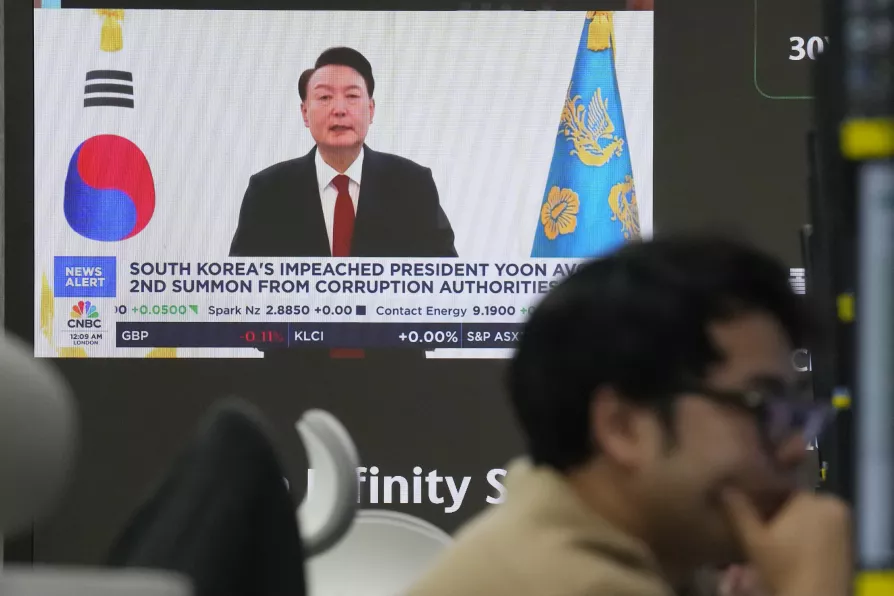Once the bustling heart of Christian pilgrimage, Bethlehem now faces shuttered hotels, empty streets and a shrinking Christian community, while Israel’s assault on Gaza and the tightening grip of occupation destroy hopes of peace at the birthplace of Christ, writes Father GEOFF BOTTOMS

 A TV screen shows a file image of South Korean President Yoon Suk Yeol, being broadcast at the KEB Hana Bank headquarters in Seoul, South Korea, December 26, 2024
A TV screen shows a file image of South Korean President Yoon Suk Yeol, being broadcast at the KEB Hana Bank headquarters in Seoul, South Korea, December 26, 2024
JUST over a month after right-wing South Korean President Yoon Suk Yeol abortively declared martial law on December 3 2024, the state remains in turmoil, contradicting highly questionable Western narratives about the Republic of Korea’s (ROK) political system.
Western media has, in the main, continued to present South Korean President Yoon’s martial law declaration on December 3 2024 as a bolt out of the Blue House — the presidential palace in Seoul. However, it has become increasingly clear that his plans were hatched some time ago.
Yoon had the support, or at least the acquiescence, of substantial sections of the country’s military and intelligence agencies. Indeed, it seems that even now, he still retains the loyalty of key sections of the state machine and most of his conservative colleagues; his popular support remains a vociferous minority.
While the main opposition group in the National Assembly, the Democratic Party of Korea (DPK), is pushing for Yoon to be put on trial for insurrection, it appears Yoon’s martial law decree was not simply a move to silence the DPK. Yoon allegedly even ordered the arrest of Han Dong Hoon, the leader of Yoon’s own ruling People Power Party (PPP).
Han resigned in early December following days of bitter post-martial law factional warfare within the main Conservative Party: “It has become impossible to carry out my duties as party chief due to the collapse of the party’s Supreme Council.”
The PPP and the DPK are both highly factionalised, with inner-party groupings having their own loyalties and corporate connections, a source of the endemic corruption that runs through South Korean political life.
When officials from the corruption investigation office for high-ranking officials (CIO) and police attempted to serve an arrest warrant on Yoon at his Seoul residence, they were blocked by more than 200 members of the presidential security service (PSS).
The PSS is directly modelled on the US secret service and reports only to the president (or, in this case, acting President Choi Sang Mak). Choi has so far evaded the National Assembly majority’s call for the PSS to allow the warrant to be served.
In the ensuing chaos of the past few weeks, Yoon has entrenched himself at his residence and attempted to mobilise his supporters on the fanatical anti-communist right.
In an open letter, which was delivered to thousands of his supporters who gathered in front of the presidential residence in the elite Hannam district of Seoul on New Year’s Day, Yoon wrote: “The Republic of Korea is currently in danger because of the machinations of anti-state forces and of forces intent on stealing our sovereignty. I will never stop fighting alongside you to defend our country.”
Yoon’s legal team have suggested that the PSS, and even civilian supporters of Yoon, have the power to arrest police officers if they attempt to serve a warrant against the semi-deposed president.
In response, Park Chan Dae, the assembly floor leader of the DPK, has said: “Insurrection leader Yoon Suk Yeol continues to lounge about at the presidential office while demonstrating zero remorse or compunction. In fact, he’s agitating for a civil war. There cannot be any delays; Yoon Suk Yeol the insurrectionist must be arrested today,” according to the anti-Yoon Hankyoreh daily.
The backdrop to this paralysis of the political and governmental elite are mass demonstrations both for and against Yoon across Korea. We seem to be witnessing an extraordinary crisis that is ripping the very fabric of the South Korean state machine as well as civil society.
It is a crisis that is laying bare both the specific internal contradictions of the South as well as the ever-present issue of the division of the Korean peninsula and the continued presence of major military and intelligence forces from the US. The latter element is almost entirely ignored by establishment media.
Certainly, Yoon’s domestic unpopularity, combined with the frustration of his political agenda by the opposition-dominated National Assembly, was the primary factor for his coup attempt.
However, a secondary factor is that Yoon seemed determined to secure US support for his power bid by manufacturing a series of security crises over North Korea — the Democratic People’s Republic of Korea or DPRK — that would force the US to back him. It is also possible that the timing, in the immediate aftermath of Donald Trump’s US presidential victory, was not entirely coincidental.
A prospective military coup by Yoon was predicted by opposition Democratic Party (DPK) MPs several months ago. On September 2, Kim Yong Hyun, Yoon’s nominee for Defence Minister, was grilled by opposition MPs at a confirmation hearing.
Kim is a retired ROK three-star general and a graduate of Chungam High School, like Yoon himself. Another member of the Chungam old boy network is Senior Lieutenant General Yeo In Hyung, the former defence counter-intelligence commander.
Given these old-school ties, Kim’s appointment, some DPK MPs suggested, opened the way for martial law to suppress anti-Yoon protests. Kim angrily told the committee: “Confirmation hearings are not a place for false propaganda based on misinformation.”
When questioned at the same hearing about his stance on South Korea acquiring nuclear weapons, Kim said: “It could be one of the options,” breaking a long-standing public taboo on proliferation.
Nonetheless, the memory of dictatorship and the resistance to it has not disappeared from popular consciousness. More independent-minded South Korean media have already unearthed some astonishing evidence of how South Korean military manoeuvres to provoke North Korea were manufactured to provide the coup plotters with a pretext for martial law.
On December 16 2024, the South Korean centrist daily paper Hankyoreh published a detailed analysis entitled “Defence Ministry’s evasiveness on alleged plans to bait North Korea into war illustrate need for formal probe.”
In the first few months of 2024, there was a trash-talking spat between the two Korean states, a not-uncommon occurrence. Seoul floated anti-DPRK propaganda leaflets across the 38th parallel, and in return, the DPRK retaliated, somewhat more imaginatively, by sending hot-air balloons filled with domestic waste and human excrement southward across the demilitarised zone.
However, in mid-October, North Korea claimed that South Korea had escalated from this “shit-for-tat” propaganda war to flying electronic military drones over the DPRK capital, Pyongyang.
An opposition DPK MP claimed that an army whistle-blower had confirmed that the South Korean military flew drones over Pyongyang under orders from the then Defence Minister Kim Yong Hyun. The drones were old training units, so slow, bulky and noisy that they appear to have been deliberately chosen to be spotted by DPRK defences and goad a response from Pyongyang.
The drone attack, which clearly had no intelligence gathering or military value, was planned by Yeo In Hyung at the Defence Counter-intelligence Command. On this occasion, the DPRK did not take the bait.
Several days after the coup, on December 8, four secure containers managed by the military’s Drone Operations Command were mysteriously destroyed in a fire at a military base. The ROK military blamed faulty wiring.
A second more direct provocation was a live fire drill conducted on November 27, when the ROK’s 6th Marine unit, stationed on Baengnyeong Island near the 38th parallel, fired over 200 shells from K9 self-propelled howitzers toward Korea’s West Sea, along the “northern limit line.”
This is considered by the ROK to be the de facto sea border between the Korean states, but according to Pyongyang, this sector falls within the DPRK’s maritime limits. Again, Pyongyang responded with restraint.
The following day, on November 28, just five days before the failed coup, the ROK military’s Joint Chiefs of Staff (JCS) met to assess any actual threat posed by North Korea’s waste-balloon launches.
Kim Yong Hyun allegedly telephoned the JCS session and demanded that the JCS unleash military strikes against the balloon launch sites inside North Korean territory. This time, the JCS pushed back, fearing that such a blatant violation of the 1953 Armistice agreement could start a shooting war, according to Hankyoreh.
It’s likely that further examples will be unearthed as the impeachment of Yoon progresses if it is allowed to. However, we should ask, what did US military intelligence know about these serial provocations in a part of the world bristling with US bases and monitoring systems?














